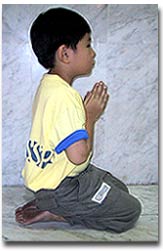Devotional Practices and Objects
This is a simple explanation of the meaning behind Buddhist devotional practices one see in shrines and temples, such as bowing, prostrating, lighting incense and candles, offering of flowers and fruit, which is common in all traditions.
Buddhist Shrines and Images
While it is difficult to imagine Buddhism without the Buddha image or Rupa, it was not until about 500 years after the passing away (Parinirvana) that the practice of making images of the Buddha started. Since that time, Buddha images have been the object of Buddhist devotion and identify for over 2000 years, acting as the inspirational focus and the means for devotees to express their reverence and gratitude for the Buddha’s Dharma or Teachings.
The reasons for the Buddha image on the shrine are:
- to remind one of the qualities of Perfect Wisdom and Perfect Compassion of the Buddha,
- it serves to inspire us to develop these qualities as we recall the greatness of the Buddha and His Teachings.
Some days, we may feel agitated, angry or depressed. When we pass by a shrine in our homes or visit a temple, and see the peaceful image of the Buddha, it helps us to remember that there are beings that are peaceful and we can become like them too. Automatically, our minds settle down.
Buddhists pay respect to the Buddha to show their gratitude to Him for showing the way to Enlightenment and liberation by:
Folded Palms
- Place the palms together and raise them to the level of the chest.
- This gesture expresses our deep reverence to the Triple Gem – Buddha, Dharma and Sangha.
Prostration
- Prostrating before an image of the Buddha or members of the Sangha expresses our deep veneration.
- This also helps us to overcome egoistic feelings (pride) to become more ready to listen to the Teaching of the Buddha.
- As we prostrate before the Buddha images, we recall the qualities of the Buddha and develop respect for their qualities such as loving-kindness, compassion, virtue, patience, concentration and wisdom. Showing respect to the Buddha and his qualities inspires us to develop these extraordinary qualities ourselves.


One manner of prostration as observed in a Theravada temple (e.g. temples of Sri Lankan, Thai, Burmese traditions)
What is the purpose of making offerings to the Buddha?
- We make offerings not because the Buddha needs them – the Buddha is an enlightened being, He certainly does not need an incense stick to be happy!
- Nor do we make offerings to win the Buddha’s favour. The Buddha developed universal loving-kindness and compassion long ago and won’t be swayed by flattery and bribery the way we ordinary beings are.
- We make offerings to create positive energy and develop good qualities such as giving with a respectful attitude and gratitude.
- Moreover, the offerings remind us of certain teachings of the Buddha.
Offering of Light (Lamp/Candle)
- Light symbolizes wisdom.
- Light drives away darkness.
- Similarly, the light of wisdom dispels the darkness of ignorance.
Offering of Incense
- When incense is lit, its fragrance spreads.
- Incense symbolizes the fragrance of pure moral conduct.
- This reminds us to cultivate good conduct.
Offering of Water
- Water symbolizes purity, clarity and calmness.
- This reminds us to practise the Buddha’s teachings, so as to cleanse our minds, which are full of desire, ill-will and ignorance, and to attain the state of purity.
Offering of Fruit
- Fruit symbolizes the ultimate fruit of Enlightenment which is our goal.
- Fruit also reminds us that all actions will have their effect.
Offering of Flowers
- The freshness, fragrance and beauty of flowers are impermanent.
- Fresh and beautiful flowers will soon become withered, scentless and discoloured.
- This reminds us of the Buddha’s teaching that all things are impermanent.
- We should value what we have now and live in the present.
The Lotus
- The lotus grows out of the mud and blossoms above the water surface, yet it is not dirtied by the mud from which it grows.
- The Buddha is likened to the lotus. Like a lotus that rises out of a muddy pond, the Buddha rose above the defilements and sufferings of life.
- We are right now surrounded by defilements and sufferings, just as the lotus seed is surrounded by dirt, mud and filth. We should rise above our defilements and sufferings, just like the lotus flower arising above the muddy water.
- This serves to remind us of our own potential Buddhahood. We may have defilements today, but we all have the potential of growing out of defilements and achieving wisdom like the Buddha.

